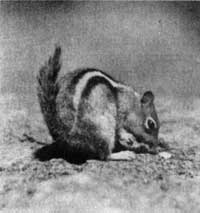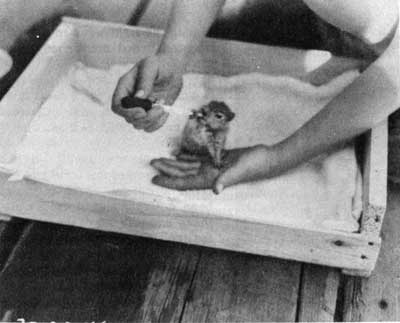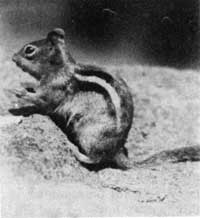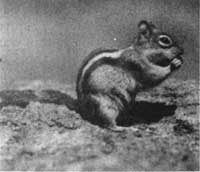|
THE GOLDEN MANTLED
GROUND SQUIRREL
by Ralph R. Huestis
Special Number - 1951
The Golden-Mantled Ground Squirrel In Crater Lake National Park
(continued)
By Ralph R. Huestis
BEHAVIOR
The inherent or unconditioned behavior of these squirrels is
interesting and can be usefully compared with the learned or conditioned
responses that are in time built up by contact of squirrels with the
park visitors. Young squirrels are quite timid upon emergence and for a
few days depend upon the early morning hours for their initial foraging,
a time when few people are around. They stay near a burrow entrance and
hole up promptly if disturbed. This timidity is typical of the behavior
of all squirrels in regions where contact with man is a rare incident.
The air of easy assurance adopted by older park squirrels is evidence of
their domesticability.

". . . tail above his back about the angle a stove
lifter projects from the lid . . ."
|
These rodents have quite a tendency to dig in the ground and the
young ones do a good deal of random digging before they actually tunnel
a home site for themselves. In digging, the head is lowered and the fore
limbs are moved very rapidly for a brief interval. The limbs are then
held still while the head is raised for a look around. Digging and
looking alternate at rapid intervals. If partly within a burrow a
squirrel will back out to raise his head for observation. When well into
a burrow, a squirrel, observed at the rim on July 15 1938, continued
digging without kicking out the loose dirt which soon covered him.
Hidden by this the squirrel continued on into the ground. About ten
minutes later he burst out head first. The maneuver simultaneously
cleared the burrow entrance and prepared it for possible retreat and got
the squirrel clear of the entrance without embarrassing him with the
adherence of loose earth. The interval had presumably been used to dig a
length of burrow and a turn around.
Interesting comparisons can be made between the golden-mantled
ground squirrel and a rather small brown gopher which occupies the same
territory and is therefore a competitor. Both mammals dig a tunnel
system, that of the gopher being attended to particularly during the
winter so that "he, while his companion sleeps, is toiling upward in the
night." The squirrel feeds for the most part above ground while the
gopher feeds for the most part underground on roots, there available, or
on greens and grains pulled through the roof of the tunnel or gathered
in short surreptitious forays launched from a tunnel entrance. In the
latter the gopher emerges headfirst but goes to earth tail first. This
reversal of direction without turning the body cannot be profitably
employed by the squirrel for he ranges for a distance and maneuvers his
body without regard to the position of the tunnel entrance. The squirrel
always goes to earth head first. However, if a squirrel partly emerged
is alarmed, he backs down gopher-like into the tunnel.

". . . hungry little squirrels were adopted and fed by
rim campground visitors."
for awhile, may even register their annoyance by scolding the intruder
as they hole up. But less blase, young squirrels, if not too greatly
alarmed, immediately "pop up" after backing down, to see what is going
on. This interesting example of youthful curiosity may be employed to
demonstrate another pattern of the remarkable specificity of squirrel
behavior. If in the game of pop up, back down, the young squirrel
emerges enough to get one hind foot on the ground at the edge of the
tunnel entrance he continues out, turns rapidly and goes to earth head
first. This experiment, performed with a number of young squirrels,
always produced the same result. The balance of advantages and
disadvantages of the alternative methods reaches a critical point when
one hind foot is in the air preparatory to complete emergence. Past this
point, when the hind foot is on the surface of the earth, the advantage
is presumably in favor of rapid emergence and immediate holing up.

"The air of easy assurance."
|
Squirrels can occasionally be seen carrying dry material which they
presumably use for bedding. Grass from the previous fall which has been
pressed down by the snow, dries rapidly when the snow has melted and so
provides an acceptable bedding material. An individual squirrel, when
not interfered with during the process, may make trip after trip to the
same site of supply and carry a load of dry grass back to a tunnel each
time. The route taken for the journey out may be repeated each time but
a different route is usually chosen for the return journey and this is
repeated on each return. An exception to this was provided by a squirrel
in the utilities area which made twelve trips in carrying old bedding
from one tunnel which it deposited in another. In this moving process
the squirrel took the shortest route between the two tunnel entrances,
which were only about thirty feet apart, and the routes going and coming
were therefore coincident.
A squirrel gathering bedding works vigorously with forepaws and
teeth to loosen grass which is taken between the jaws. The squirrel then
stands up and trims this load into a neat bundle. More grass may be
added and the trimming process repeated. Thus to arrange the load
between the jaws a squirrel makes rapid and complicated movements with
the forepaws. As a result he can run with his grass sheaf without
stepping on loose ends and as the bundle does not project laterally much
further than the ears the squirrel can enter a tunnel entrance on the
run without embarrassment. A squirrel running with bedding has been seen
to stop, stand up and retrim his load when a loose end of dried grass
became detached and started to drag. On one occasion a squirrel running
down the inner wall of the Sinnott Memorial ramp, stopped at the lower
turn where two visitors offered him peanuts. To accept these the
squirrel was obliged to put down his sheaf of grass and by running down
the ramp the writer was able to prevent the squirrel from retrieving the
grass before he ran away. This grass sheaf was in the form of an 8 which
the squirrel had been holding in the center so a loop projected on each
side. The grass in this bundle held together and could be lifted by the
center or either loop without becoming disentangled.
Like most rodents the golden-mantled ground squirrel grooms himself
around the head, neck, and belly with his fore paws. Hinder parts except
the tail, are worked over with the teeth. The tail is combed by a sort
of shucking motion with the fore paws and combed with the teeth as well.
Grooming is particularly important in small mammals since a smooth coat
conserves heat which radiates rapidly from the relatively large surface
of a small creature. Squirrels dust themselves by a moderate rolling in
dust piles often raised by a few rapid paw strokes for the purpose. They
frequently save time by diving into dust like a base-runner making a
head-first second. Frequently after the dive they lie spread-eagled in
the dust for a brief period and this same position, with all limbs
extended, may be used in resting. A well nourished little squirrel thus
stretched out, after an interval of peanut gathering, has all the air of
smugness carried by a lucky investor after a hard hour of coupon
clipping.

". . . edible objects are always lifted first by the
jaws and then transferred to the forepaws . . ."
|
Squirrels forage busily and nose over the ground for food. They
frequently forage by standing on the hind limbs while they reach out and
pull vegetation to the mouth with the fore paws. In this manner they
nibble young leaves and flower buds of Newberry's knotweed and
bleeding-heart and the seeds of wild grasses, the heads of which they
obtain by arm over arm reeling in of the stem. It is interesting that in
spite of this use of the fore limbs in a special circumstance, that
edible objects like peanuts are always lifted first by the jaws and then
transferred to the fore paws for manipulation during husking or
fragmentation prior to storage in the cheek pouches. Occasionally a
squirrel with its mouth full of food will clutch an object on the ground
and pull it toward the body but will then merely hold it with its paw
until the mouth can be used as the grasping organ.
The golden-mantled ground squirrel has a vocabulary of at least four
different sounds. There is a high- pitched "peesk" which is quite
bird-like in tone, sometimes followed by a trill which is rather more
musical than the similar trill of the western chipping sparrow. Both
single and multiple noses seem prompted by excitement or alarm. These
sounds are made while sitting, sometimes with one foot raised. The mouth
is widely opened for the first sound and the body vibrates obviously
with the trill. On August 6, 1938, the writer stopped to investigate a
singing squirrel which had gathered an audience of a number of campers.
One of them estimated that the squirrel, presumably a female since it
was occasionally followed by young, had already sung for an hour and
"sang almost every day!" There is a throaty little growl which is
uttered as a warning to interlopers and during pursuit of them or while
in the throes of combat. This sound is commonly employed when squirrels
are competing for peanuts. Rather rarely a squirrel running from a
pursuer, utters a series of high squealing notes when pursuit is close.
In general these animals are rather silent and are usually credited with
the single note first mentioned (Bailey, 193, p. 140).
|

